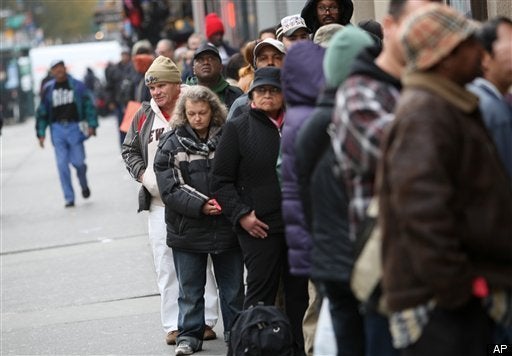
Due to high numbers of unemployed and underemployed families, more people showed up at Salvation Army programs across the country looking for food in 2010, but nearly two-thirds of those programs saw a decrease in food and money donations.
According to an internal survey conducted in the fourth quarter of 2010, 94 percent of Salvation Army food service programs reported some level of increase in requests for food assistance over the previous year. The Salvation Army is one of the largest social-service organizations in the world, and is the largest direct provider of social services in many cities throughout the United States.
The report shows a marked increase in new clients, ranging from middle class families to the working poor, as well as younger generations looking for work.
"Here in Minnesota we have the new poor, the working poor, the underemployed, the unemployed -- it's a dynamic shift in the population of people coming in," said Major Darryl Leedom, the Salvation Army's regional commander for Minneapolis and St. Paul, Minn. "Many of those individuals have already exhausted their savings and financial support from friends and family, so it took them a while before they found it necessary to come in for food assistance."
Leedom told HuffPost the new families he sees coming in are often surprised and embarrassed to find themselves in the position of asking for help.
"They're a little bit ashamed -- no one likes to think they need something as basic as food," he said. "They'll say, 'I've never had to do this before, we've never walked by one of those red kettles without putting money in.' And we say, 'Our role is to embrace, empower, encourage, equip. We hope there's a day you wont need to come to us, but for right now, let's journey though this together.'"
Nationwide, monetary and food donations to Salvation Army food programs from government, public and private donors were all down in 2010. More than a third of programs surveyed said their funding decreased by as much as 50 percent and that their food stocks were running low to dangerously low.
Leedom said this lack of funds and supplies has forced each local program to be more creative about acquiring food.
"In 2009, through contributions from grocery stores, etc., 850,000 pounds of food were distributed, which is huge. We were able to beef that up through some other food-salvage efforts to over 953,000 pounds in 2010, despite a shortfall in finances, by pushing up our in-kind support," he said. "That means that before something expires, a grocery store will call us, and we pick up the items and then haul them to our neighborhood centers."
Salvation Army Commissioner William Roberts wrote in the report that he expects this high demand for food to continue into 2011, especially during the winter months, and he hopes people will dig deep and donate.
"To meet this demand in 2011, The Salvation Army is calling upon donors and other supporters everywhere to continue volunteering or giving back -- either to The Salvation Army or another charity -- to help ensure that not a single American goes hungry," Roberts wrote.
Donors and volunteers can learn more about giving to The Salvation Army by visiting www.SalvationArmyUSA.org or by calling 1-800-SAL-ARMY.
